Locating a suitable site is the key to success in cultivating Eucheuma seaweed. Numerous factors influence the growth of Eucheuma and should be considered while choosing a farming area. These are listed below.
Water Temperature
A water temperature ranging form 25 °C to 30 °C is best for growing Eucheuma. In shallow waters near the beach, the water temperature can become quite high especially during a sunny day. Such an area is not suitable for planting seaweed. In fact, even though you might think that the shallow sandy bottom is good for securing your stakes, the high water temperature will kill your plants.
So, we suggest that you set your farm away from the lowest tide mark (spring low tide limit). A good area is the one between the spring low tide limit and the reef edge or an area which does not dry up during these big low tides occurring during full or new moon.
Water Salinity
Minimum water salinity required is about 28 ppt (parts per thousand) or more. Salinity is the term used to indicate the amount of salt you can measure in sea water. Do not worry! By tasting a few drops of salt water in your mouth, you can feel the difference in salinity. Brackish water at the river mouth will taste less salty than ocean flowing water. Be sure that you do not plant your seaweed in front of a river mouth or in fresh water, as fresh water will kill the seaweed.
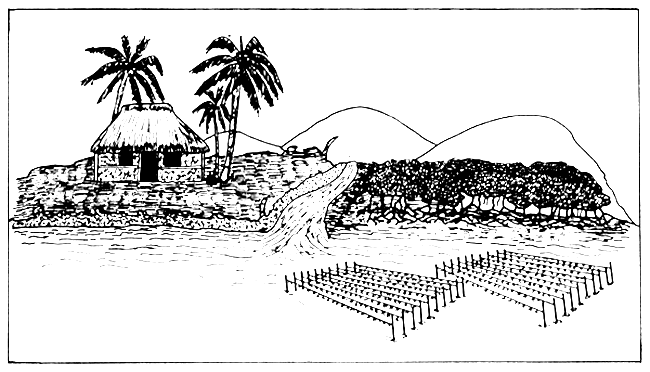
In the drawing is represented a bad situation. Do not set your farm in front of a river mouth.
Bottom Type
A white sandy bottom with the presence of a limited amount of natural seaweed, is probably the best place to cultivate Eucheuma. If the bottom is covered with seagrass, Eucheuma will not grow very well. This is because other seaweeds might compete, absorbing the nutrients from the water leaving your Eucheuma plants starving. In this situation, your plants might be covered with unwanted seaweeds and as a result, silt will quickly deposit on them.
A sea bottom with hard coral formations and coral heads is not a good site to establish your farm. In such areas it is difficult to secure your stakes. In addition, plant eating fish generally live and aggregate around coral heads. From here, they move out from time to time to graze on your seaweed. As a result, they damage your plants.
A muddy sea bottom, is also not advisable for your farming site because silt or mud will cover the plants reducing the seaweed growth and some extra work will be necessary to shake and keep clean your plants. Also murky water will limit the amount of sunlight that is supposed to reach your plants.
Now you can see why we suggest you choose a nice white sandy bottom to set your farm.

| BAD | GOOD | BAD |
|---|---|---|
| Too many corals | Nice clean sandy bottom | Too many seaweeds |
Water Movement
Moderate water movement is mostly preferred to strong water current like the one you can see close to the reef edges or in its passages. If the water current is too strong, it can damage your plants and even wash away your planted lines by pulling down the stakes. It will also slow down your work as it is difficult work in areas with strong swift current.
However, be sure that there is a constant exchange of ocean water as the one you have with the changing of the tides and sufficient water movement as the one created by waves. This will bring the necessary nutrients to the plants for a healthy growth.
As for any type of farming, the supply of nutrients is an essential factor for growing your crops. This applies to seaweed cultivation too. Therefore, remember to consider water movement as an important factor for seaweed growth while selecting the area for your farm.
You must be sure that the farm is placed in such a direction that the water current flows into the farm and not against it as shown in the drawing.
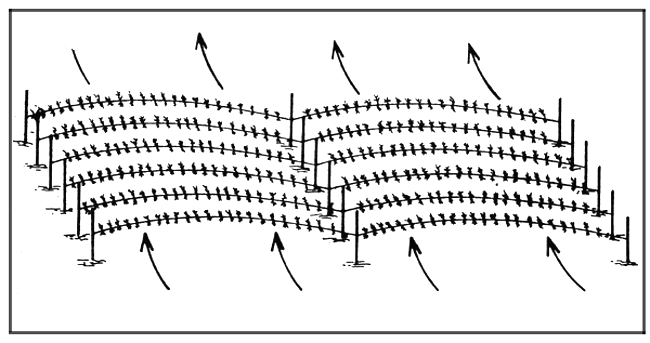
In this drawing you see a seaweed farm set against water current. Strong water current can bend or even break the lines. This is not a good way to follow.
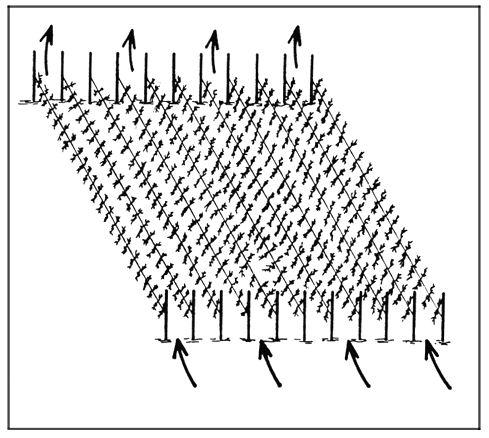
In this drawing, water current flows into the farm and not against it as above. This is a good example to follow.
Sunlight
Eucheuma requires sufficient sunlight for growth. Sunlight is used by Eucheuma as a source of energy for its growth and to manufacture carbohydrates like carrageenan, the commercially valuable substance inside the seaweed. Thus, it is essential to have plenty of sunlight. Clear seawater allows sunlight to penetrate more easily to the plants. This is why when seaweed is planted close to the sea surface, it grows faster and healthier compared to that planted close to the sea bottom or in deep water.

| GOOD | BAD |
| Seaweed planted in shallow water near the surface (30 to 50 centimeters) receives plenty of sunlight and its growth will be good. | Seaweed planted in deep water (more than 1 meter from the sea surface) does not get enough sunlight and its growth will be poor. |
Water Depth
At least knee deep water at spring low tide (0.5 meter) is the minimum water depth required to cultivate Eucheuma. In shallower waters seaweed can still grow, but it might be exposed to direct sunlight and wind. As soon as your seaweed is exposed to sun and wind, the tender tips of the plants are destroyed and if exposed for a long time (2 to 3 hours), the whitening of the branches can be seen. This will indicate that part of the seaweed has been killed. Eventually branches will break and drift away from the whitened area.
So, it is important to consider the water depth while selecting the area of cultivation.
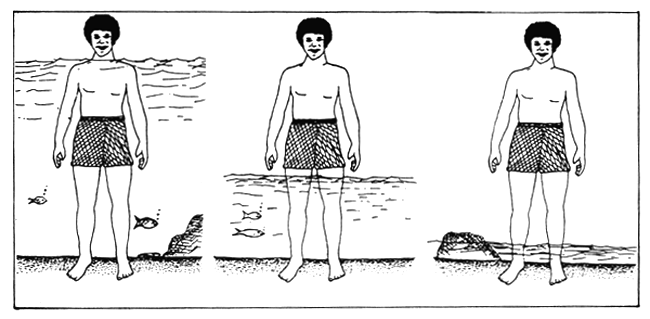
| BAD | GOOD | BAD |
| Too deep at spring low tide | Sufficient water depth at spring low tide | Too shallow at spring low tide |
Water Pollution
Because Eucheuma prefers clear water and plenty of sunlight, even turbid water (muddy) will not sustain good seaweed growth.
Chemical pollution will kill the seaweed as in the case of most marine plants and animals.
We suggest, after you select one location you think is good to grow Eucheuma, to plant several lines of seaweed in various spots within that area and observe its growth. This will be the best way to find out the ideal area for farming.
There are at least 3 methods you can use to cultivate seaweed. They are known as:
Off-bottom (fixed bottom) Method
Raft or Floating Method
Longline Method
Off-bottom Method
As you can see in the figure below, wooden stakes are driven into the sea bottom 20 to 25 centimeters apart form each other in straight rows. The stakes should be 5 to 10 centimeter in diameter and 1 or 1.5 meter long. At least 0.5 meter of the stake should be driven into the sand to make them secure.
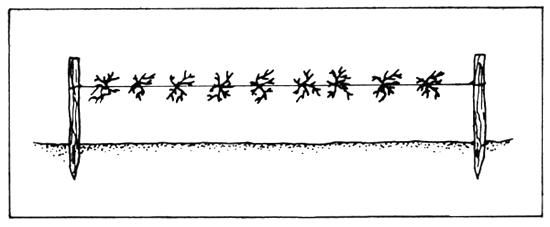
Drawing showing how a seaweed line is typically suspended in the Off-bottom Method.
A 3 millimeter thick polypropylene rope 5 meters long is firmly stretched between two stakes. Attached to the 3 millimeter rope (line) are 30 pieces of raffia (polypropylene strings). Each of your planting material (seed), the size of the palm of your hand (150 grams), is tied to the raffia strings. The 3 millimeter rope, is suspended at least 20 to 30 centimeters from the sea bottom to prevent the growing seaweed from being tossed on the sand and 20 to 30 centimeters below the water surface at low tide to avoid the seaweeds from being exposed to direct sun light. Direct sun light will kill the exposed parts.
Stakes must be sharpened at one end so that they can be easily driven in the sand. You can use mangrove stakes or any other bush timber which does not rot easily in sea water.
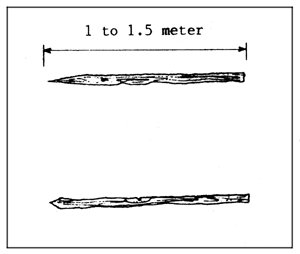
Note in the drawing above how wooden stakes are sharpened in different ways. Use the type of sharpening as shown in the top stake.
Be sure to tie the seaweed seeds in the correct way as shown in the figure below.
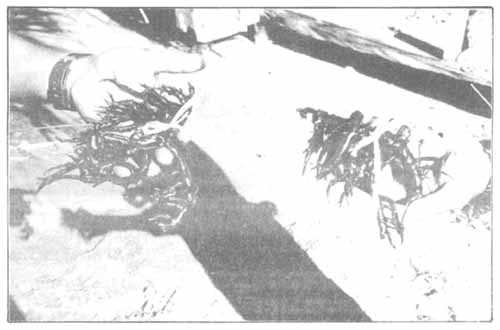
Photo of seaweed seeds tied with raffia strings to a 3-millimiter line. Note the type of slip knot used.
The raffia strings, should be 20 centimeter in length with both ends knotted to prevent fraying as shown in the previous photo. The raffia strings are firmly tied to a 3 millimeter rope in such a way that it will not move along the rope as the seaweed grows bigger, or during rough weather.
If you are preparing your lines with seed on the shore, make sure the seaweed is covered and, when possible, prepare your lines at night or in the shade during the day. Your seed will remain alive out of the water, if you keep it moist.
Try your best to prepare the lines as quickly as possible and place them in sea water. Remember, the seaweed seed will grow better if you limit the time the seaweed is kept out of the water.
Also, remember that you need to tie the raffia strings to your lines on shore before you tie your seaweed seeds to them as shown in the photo below.

Village women preparing seaweed lines on shore. The lines can be stretched between two posts or coconut trees. You can hammer a row of nails into the posts and easily tie the lines to them.
If you want to follow the off-bottom method to cultivate your seaweed, you can prepare the lines either on shore, in the shallow water at low tide, or in your punt near the farm.
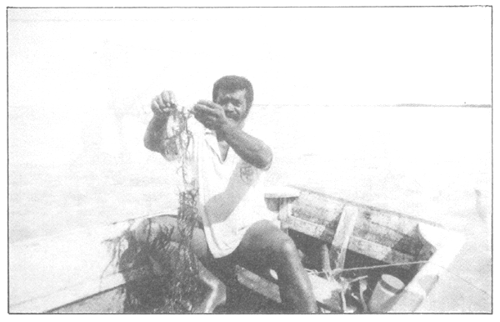
Farmer preparing seaweed lines in a punt. At low tide the lines can be easily stretched standing in the shallow water.
Raft or Floating Method
In the floating method, seaweed is attached to some device that keeps the seaweed floating; rising and falling, with the tidal changes.
Following this method, be sure to keep the seaweed about 50 centimeters below the water surface.
The floating devise can be a simple frame made of bamboos, mangrove wood, or bush timber durable in seawater. You can tie together four 2.5 meter long bamboos into a square frame and stretch 3 millimeter ropes (lines) inside the frame.
In a 2.5 meter square frame, you can stretch up to 15 lines, 10 to 15 centimeter apart. Each line will carry 15 pieces of seaweed tied to the 3 millimeter rope with raffia.
In a frame like the one described, you can plant up to 225 pieces of seaweed.
In this method you can tie your seaweed on shore by placing the raft on a support (oil drums or wooden posts). In this way it will be easy for you to tie your seeds to the lines.
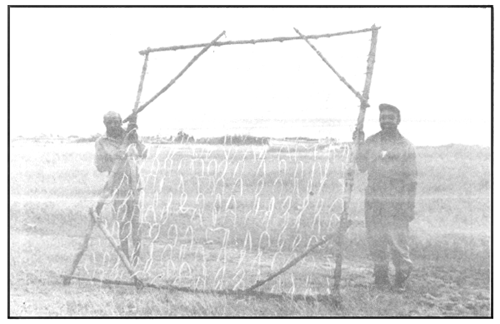
Photo of a square floating frame built with mangrove wood.
The square floating frame, should be anchored to the sea bottom as shown in the figure. As the seaweed starts to grow and become heavier, the frame will sink. To avoid this, be sure to attach to the frame extra bamboos or floaters. Floaters can be simply made of styrofoam or bags filled with unhusked coconuts.
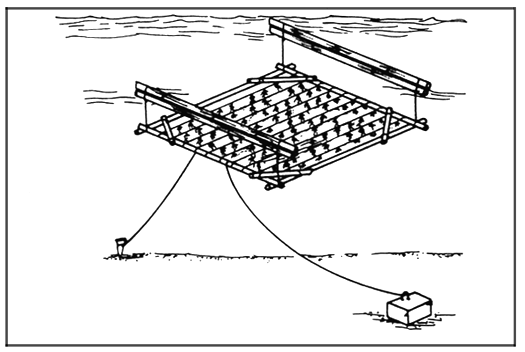
Drawing of a floating frame with additional bamboo to assure sufficient buoyancy.
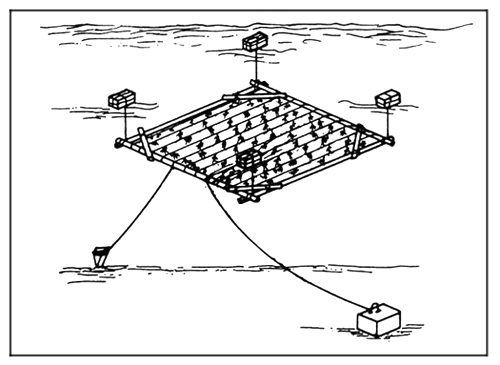
You can use other float materials as shown in the drawing to assure a sufficient buoyancy.
Longline Method
The longline method is similar to the raft or floating method in several ways. In fact, seaweed is hung to a rope which is suspended by floaters. In this method, however, the main rope is thicker; about 10 to 15 millimeters in diameter. This rope is tied to plastic floaters or bamboo set at 4 to 5 meters interval and anchored at each end. The pieces of raffia holding the seaweed, can be tied to the main rope in two ways.

Simplest way. The raffia string are directly tied to the main rope.

Additional pieces of rope, 0.5 to 1 meter long, can be tied to the main line and the raffia strings can be tied to them.
Remember that your seaweed has to be hung near the water surface to receive sufficient sunlight. You can suspend the main line about 0.5 meter below the water surface.
As described in the first two methods, the lines can be prepared on shore. Generally, in the long line method, if you prepare your lines on shore, it will be difficult to stretch them since they are heavy and may tangle easily. If so, you might loose some seaweed seeds. We suggested, that you tie your seaweed seeds to the main line once the line is already stretched and suspended with floaters. You should prepare the lines from your punt as shown in the drawing below.
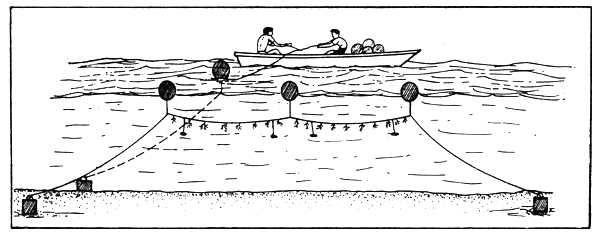
Drawing of a longline being shot from a punt.
| Advantages | Disadvantages | |||||
| Off-bottom Method | ||||||
| 1. | Simple to construct | 1. | Difficult to locate a good area | |||
| 2. | Easy to manage | 2. | You might lose your crop during rough weather | |||
| 3. | You can prepare your lines on shore | 3. | You cannot move your farm if needed | |||
| 4. | Do not require much money to start | 4. | You might find more grazer fish around your seaweed | |||
| 5. | You can use local wood to prepare the stakes | 5. | You need to construct a drying rack | |||
| 6. | The farm is easy to reach at low tide | |||||
| Raft or Floating Method | ||||||
| 1. | Can be utilized in shallow or deep waters | 1. | You might have difficulty finding bamboo | |||
| 2. | You do not need a sandy sea bottom bed | 2. | You need to find float materials | |||
| 3. | You can move your floating rafts if you need to | 3. | The frame might break or sink during rough weather | |||
| 4. | Most of the planting can be done on shore | 4. | The frame can be damaged by motor-driven boats | |||
| 5. | You do not need to construct a drying rack | 5. | You might need somebody to help you to handle the frame | |||
| 6. | You can use local wood to construct your frame | |||||
| 7. | The seaweed seems to grow faster | |||||
| Longline Method | ||||||
| 1. | You can set your longline almost anywhere | 1. | The ropes are costly | |||
| 2. | The seaweed seems to grow faster | 2. | Planting and harvesting cannot be easily done on shore | |||
| 3. | You can move the longline to another area | 3. | You need to buy expensive floaters | |||
| 4. | The longline can be damaged by motor-driven boats | |||||
When you need to transport your seaweed seeds from one place to another, as in the case of taking your seeds to another village or even when you want to take seaweed at home to prepare your lines, you should consider that the seaweed is a living plant and needs particular care.
The first thing you should do, is to cover your seaweed with tarpaulin or coconut leaves. If you know that you will be travelling for several hours moving your seaweed, it is advised to put it in jute or onion bags. It is very important to keep the seaweed moist at all times. You can pour sea water over the bags or, when you have a chance, dip the bags in the sea.
You can also use styrofoam boxes to transport your seaweed. In this case, make a few holes on the upper edges of the box to facilitate aeration. Remember to keep the seaweed moist. Do not fill the box with seawater as this will make the seaweed rot rapidly unless the sea water is constantly circulated.
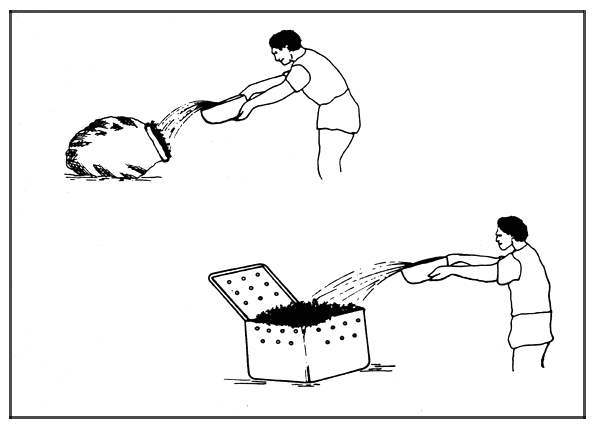
Drawing of seaweed farmers pouring seawater over a jute bag and a styrofoam box filled with seaweed.
Even when you carry seaweed seeds on your punt to the farm site, keep the seeds covered to protect them from direct sunlight. Pour some seawater over them at regular intervals. Preparing the lines from your punt, might take several hours and if not covered and kept moist, the seaweed seeds will be spoiled.
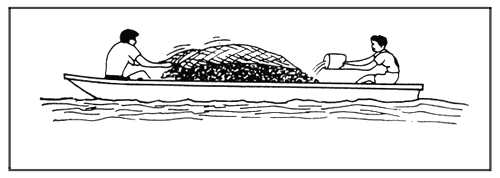
Drawing of seaweed farmers bringing seaweed seeds to the farm site for planting.
You might wonder why you should cover and keep your seaweed moist. This is to avoid the seaweed being exposed directly to sunlight, wind and rain. Seaweed, needs to be kept moist, cool and protected to survive out of the water.
You should keep in mind that there are several factors that can damage your farm. These might occur especially during the warmer months of the year, from December to April. During these months, seaweed is more susceptible to diseases and is readily harmed by grazers. Also during this period, the growth of Eucheuma slows down and cyclones and bad weather may cause some damage to your farm. Drying in this period can also be difficult, as it is the wet season in Fiji.
Natural predators
As frequently observed, rabbit and puffer fish are the main seaweed grazers. In addition to these, sea urchins and sea turtles are also often seen damaging the seaweed plants. Among all of these, rabbit fishes are usually the most destructive.
During the warmer months, large schools of rabbit fish 1 to 6 centimeters in length, can be seen living among your seaweed lines. On some occasions, these small rabbit fish have grazed seaweed to such an extent that they have entirely destroyed seaweed farms.
After the warmer months, the rabbit fish grazing becomes a minor problem. In fact, rabbit fish move away from the seaweed. It is always a good idea to set your farm far away from coral heads, since these fishes normally live around the corals and move out to graze on seaweed.
Do not leave rubbish (tins, unused stakes, bits of wood, etc.) as these make a very good home for rabbit fish.
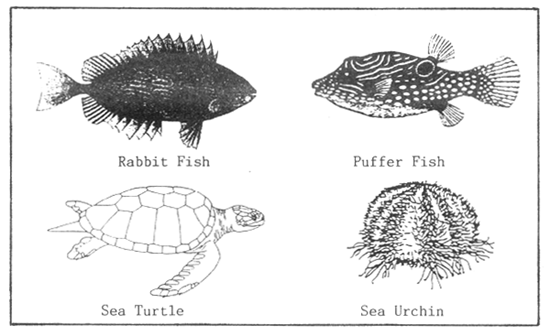
Drawing of the most common seaweed predators. Among these, rabbit fish is the most unwanted.
Diseases
Even though there are no specific diseases that might affect Eucheuma, in situations where plants are heavily grazed it is common to observe whitened areas on their branches.
Whitened areas are more exposed to fungal infection. Especially during the warmer months, fungal infection can spread quite rapidly and the seaweed plants show large portions of discolored branches commonly seen as white and pink areas. “Ice Ice” is the common term used to describe seaweed plants in this condition.
Weather
Apart from occasional bad weather (rough sea and heavy rain), the effect of cyclones occurring during the summer months can be devastating. Cyclones cannot be avoided, but what you can do is take precautions.
During the cyclone season, you should listen to the radio weather forecast regularly and carefully. If a cyclone is expected, harvest as much seaweed as you can and keep it on shore protected from wind and rain.
Put aside sufficient seaweed to allow you to re-start farming after the cyclone has passed by. Remember you need to keep this seaweed in bags moist with seawater at all times. That seaweed will be your re-planting material.
If seaweed is kept small during this period, and not allowed to become over-mature, little damage is expected. You might decide to harvest after 4 or 5 weeks of growth instead of waiting for 6 or 8 weeks. Experience after going through several cyclones suggest that this strategy could limit your damage.
Also, be sure that your stakes are firmly erected otherwise the strong water currents and swells during cyclones might wash away your effort.
After the cyclone has gone through, tangled lines should be entangled and secured again. Badly damaged seaweed should be completely removed and replaced with new seeds.
If you are heavily hit by a cyclone but you have not lost all your seaweed, then it is possible to be back in full business again after 8 weeks. A lot of work has to be done and done quickly, but it will worth it.